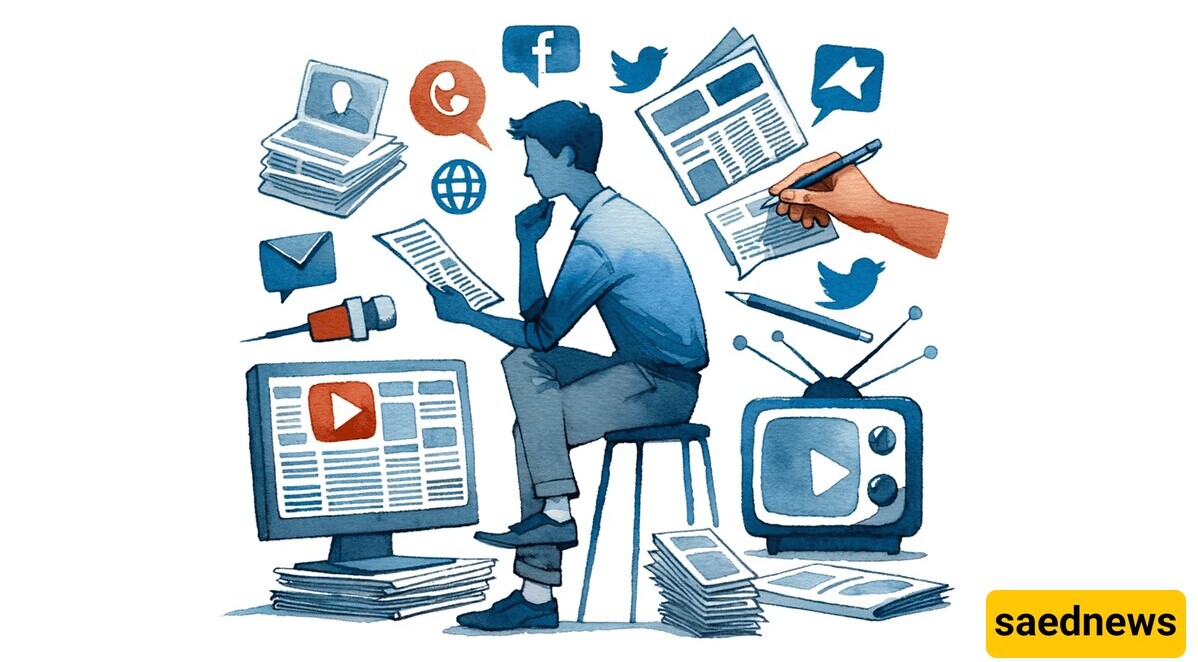Saed News: In a world where media constantly delivers captivating and impactful messages to our minds, do we have the ability to distinguish truth from distortion? Media literacy is a skill that can transform you from a passive consumer into an informed and critical audience.

According to the Society Service of Saed News, in today's world, we are constantly surrounded by media—from smartphones to television, social networks, and print media. In this fast-paced environment, a flood of information continually flows toward us. To better understand what is happening around us, we need tools to help us navigate this massive volume of information. This is where media literacy becomes essential.
What is Media Literacy?
Media literacy can simply be defined as the ability to recognize, understand, and analyze media content. This skill helps us engage with media actively and intelligently, allowing us to evaluate information critically instead of blindly accepting everything presented to us.
In the world of media, every piece of content that is produced and published carries specific messages and objectives. Media literacy empowers audiences to respond to these messages consciously and transform into thoughtful and analytical consumers rather than passive recipients.
Why is Media Literacy Important?
Imagine sitting at a dining table filled with colorful and diverse dishes. Are all of them beneficial for you?
Media literacy acts as a dietary guide, teaching us what to consume and what to avoid. It enables us to choose healthy and appropriate content while steering clear of messages that might harm us or contain false information.
A critical principle of media literacy is understanding that media content does not always represent an accurate depiction of reality. Media functions like a factory where the final product—be it news, films, or programs—is created based on specific goals.
These goals might serve particular groups or ideologies. Media literacy helps us identify these objectives and analyze messages within a broader context.
For instance, an advertisement might present an idealized and attractive image of a product. But how closely does this image align with reality? Similarly, a news story from a specific source may not be entirely neutral or free of bias.
These are precisely the questions a media-literate individual asks, enabling them to make informed and critical evaluations of the content they encounter.

Components of Media Literacy
Media literacy is a combination of various skills and abilities that collectively prepare us to better understand media:
1. Cognitive Skills: These help us comprehend media messages, recognize their signs and meanings, and understand the reasons behind their delivery.
2. Sensory Perception: We interact with media through our five senses. Understanding the role of sound, visuals, and other special effects in conveying messages is part of this skill.
3. Aesthetics: Every media message has an artistic dimension. Recognizing these aspects allows us to analyze media content not just as a message but as a work of art.
4. Ethics: The moral and spiritual values embedded in media messages are a critical part of analyzing their content. Examining how well a message aligns with ethical principles and social justice is essential.

Media Literacy in Everyday Life
Understanding the concept of media literacy might seem complex at first glance. However, simple everyday examples demonstrate its importance: Imagine watching a film where a 10-year-old boy transforms into a 40-year-old man. For an average viewer, this scene might be confusing. However, a professional cinema audience knows this transformation is part of the cinematic language and sees no reason for concern. Or consider trying to fly an airplane without sufficient knowledge and skills—you would undoubtedly crash. Media literacy works in the same way; it is a tool that helps us correctly navigate and analyze media messages.
The Relationship Between Media Literacy and Social Justice
One of the key goals of media literacy is to assess media content in relation to social justice. Media messages should serve values such as freedom, equality, and justice. Unfortunately, in many cases, media become tools for strengthening the ruling power or benefiting specific groups. Media literacy empowers the audience to identify such messages and prevent their negative impacts.
Media Literacy for Everyone
Media literacy is not only essential for adults but also for children and adolescents. Teaching this skill to children can help protect them from the negative influences of media messages. Teachers and educators, by having media literacy, can pass this skill on to younger generations, turning them into informed and critical consumers.

Media Literacy is a Necessity, Not an Option
In a world constantly influenced by media, media literacy is no longer a choice but a necessity. This skill not only helps us better understand media messages but also turns us into informed, analytical, and active consumers. Media literacy is a tool that allows us to use media intelligently and make informed choices, rather than getting overwhelmed by the flood of information.
For more community-related articles, stay connected with the community section of SaadNews.

